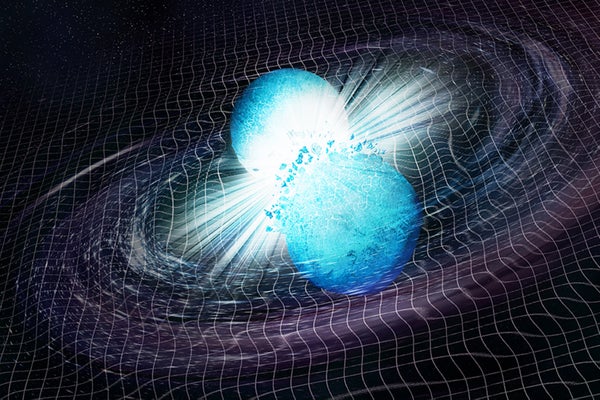Inside a neutron star—the city-size, hyperdense cinder left after a supernova—modern physics plunges off the edge of the map. There, gravity squeezes matter to densities several times greater than those found in the nucleus of an atom, creating what theorists suspect could be a breeding ground for never-before-seen exotic particles and interactions. But densities this high cannot be probed by laboratory experiments, and remain too challenging for even today’s most powerful computers to tackle.
So when the universe deigned to help out, astronomers jumped at the chance. Last August the Advanced Laser Interferometer Gravitational-Wave Observatory (LIGO), along with a European detector named VIRGO picked up gravitational waves reverberating through spacetime from the merger of two neutron stars some 130 million light-years from Earth. Those waves, now reanalyzed in a new paper by the LIGO–VIRGO team, provide some of the best hints yet about the nature of the merger’s progenitors—and what neutron star stuff actually is.
As the two stars circled toward mutual doom, shedding orbital energy into gravitational waves, they also began raising tides on each other’s surfaces. Those tidal interactions sucked away even more orbital energy, tightening the neutron stars’ orbit and hastening their collision. The strength of those tides, baked into the gravitational waves detected by LIGO–VIRGO, depended on each neutron star’s internal structure, which physicists model using an “equation of state.” For a neutron star an equation of state mathematically describes how the star’s innards react to changes in density, pressure and temperature.
On supporting science journalism
If you're enjoying this article, consider supporting our award-winning journalism by subscribing. By purchasing a subscription you are helping to ensure the future of impactful stories about the discoveries and ideas shaping our world today.
The new study follows up on an initial calculation released last October by the same team, which had failed to detect these tides in the gravitational wave signal at all. “Our first analyses were fairly ‘eyes wide open’—we made few assumptions,” saysJocelyn Read at California State University, Fullerton, who leads LIGO’s “Extreme Matter” team.
On the second go-round, though, the team looked at more orbits of the two objects and added in some additional constraints. Namely, they assigned both objects identical equations of state—a reasonable assumption, given that all available data about the merger make it all but certain that the collision’s source was a pair of neutron stars.
Next, they tested possible equations of state that could explain the data, adding other sensible, real-world requirements. For instance, pressure and density changes could not create sound waves moving faster than the speed of light inside a neutron star (or any other object, for that matter). And the equation of state had to also fit the heaviest confirmed neutron star, which weighs in at roughly 1.97 solar masses. If neutron star material could not sustain sufficiently high pressures, such an object would not be a neutron star at all—it would have long ago collapsed into a black hole.
Taking all that into account, the new analysis finds the two neutron stars involved in the merger, each weighing perhaps 1.4 solar masses, were rather small for that weight: about 12 kilometers in radius. That would match previous controversial x-ray measurements of neutron star radii. And it hints midsize neutron stars possess relatively low interior pressures compared with the 1.97–solar mass heavyweight, which must have higher pressures to provide a stiff backbone against such crushing gravity.
Compared with lab measurements of matter at much lower densities, the new data show tentative hints of an upward bend in how pressure increases in denser and denser matter. Such a bend would not be expected if neutron stars are made solely of neutrons and protons—in that case, pressure should just increase smoothly. “There could be some interesting structure in the equation of state emerging,” Read says, adding the caveat that the data are also still consistent with a steady growth of pressure, corresponding to a “boring” neutron star made of only protons and neutrons. If physicists can confirm a bend like this in the equation of state, though, it might be a clue matter changes phase at very high densities, much like water changing from liquid to solid at sufficiently low temperatures. In neutron stars such a phase transition could arise from neutrons breaking apart into a soup of their constituent particles, quarks.
The new study echoes the findings of a previous analysis of the same event published in April by a team led by graduate student Soumi De at Syracuse University, but with twice the precision. “That’s encouraging, that this one event is not yet fully exploited,” says James Lattimer, an astrophysicist at Stony Brook University and a co-author on the earlier paper.
Both Lattimer and Read’s teams plan to keep reanalyzing last August’s signal. “We haven’t wrung everything we can out of this,” Read says. Soon, signals of additional neutron star mergers are likely to emerge from gravitational-wave detectors, providing even more data for astrophysicists hoping to pin down these exotic objects’ equation of state.
In the meantime there’s another helpful result, published in The Astrophysical Journal Letters in May. In the aftermath of last August’s neutron star merger, other astronomers scoured its wreckage with the Chandra X-Ray Observatory, hoping to glimpse its ultimate outcome: a single, heavier neutron star or a black hole.
A single giant neutron star weighing roughly 2.7 solar masses would have far outweighed the previous record holder, forcing the neutron star equation of state to accommodate an even tougher constraint. But it was not to be; the Chandra data revealed relatively few x-rays streaming from the merger’s wreckage, an observation consistent with the formation of a black hole. According to Lattimer, that’s interesting as its own limit—astronomers now know neutron star matter cannot possibly support so much weight. “I don’t think I thought imaginatively enough about all the things that mergers are going to be able to tell us,” he says.
